|
| |
|
Collecting Islamic Prayer Rugs
by Bob Brooke
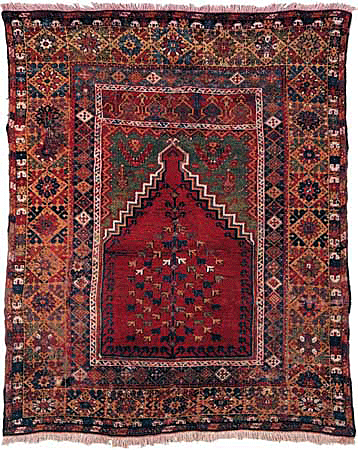 In
June 1325, a 21-year-old man known as Ibn Battuta set out on a journey
of a lifetime that would last more than 30 years and span the globe. He
had little money and just a few cherished possessions, among them a
prayer rug. He carried this wherever he went for it was his companion. In
June 1325, a 21-year-old man known as Ibn Battuta set out on a journey
of a lifetime that would last more than 30 years and span the globe. He
had little money and just a few cherished possessions, among them a
prayer rug. He carried this wherever he went for it was his companion.
To Muslims around the world, a prayer rug, also known as sajjadat
salat, a term that comes from the prostration worshipers do during
Islamic prayers or sujood—can be found in every Muslim home and
is often a constant travel companion.
During prayer the supplicant kneels at the base of the rug and places
his or her hands at either side of the niche at the top of the rug, his
or her forehead touching the niche. Typical prayer rug sizes are
approximately 2 1/2 × 4 feet or 4 × 6 feet , enough to kneel above the
fringe on one end and bend down and place the head on the other.
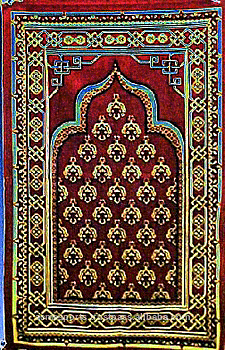 From
different designs, textures and colors, and from the earliest ones made
of palm fronds and reeds to the finest threads and a single prayer rug
can tell many stories. From
different designs, textures and colors, and from the earliest ones made
of palm fronds and reeds to the finest threads and a single prayer rug
can tell many stories.
It all began with the Prophet Mohammed, who prayed on a “khumrah,”
a mat made of palm fronds.
A prayer rug is a piece of fabric, often a small carpet, which Muslims
place between them and the ground or floor of the mosque for cleanliness
during prostration and sitting during Islamic prayer. A Muslim must
perform wudu, or ablution, before prayer, and must pray in a
clean place. Designs of prayer rugs reflect the village they came from
and the weaver. Prayer rugs have been traditionally woven with a
rectangular design, typically made asymmetrical by a niche at the head
end.
The History of Prayer Rugs
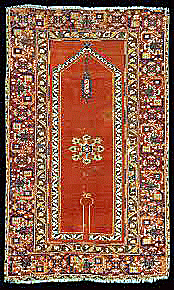 Although
carpet weaving originated in Central Asia more than 2,000 years ago, it
was the Islamic culture that turned it into an art form. Carpets were
something to walk on, sit on, sleep on, and yes, pray on. Although
carpet weaving originated in Central Asia more than 2,000 years ago, it
was the Islamic culture that turned it into an art form. Carpets were
something to walk on, sit on, sleep on, and yes, pray on.
A simple yet significant piece of cloth, the prayer rug started to
intrigue influential Muslim leaders early on; they would commission
their court’s greatest artists to create rugs fit for rulers and to be
given out as gifts to other leaders.
Under the Ottoman, Safavid and Mughal dynasties, the industry flourished
and carpets came to be considered as national treasures. They were
traded to Europe and the Far East, often considered too precious to be
prayed on and would end up being hung like a painting in a home or
palace.
Weavers competed to make the most beautiful prayer rugs, and the
different tribes or groups would work hard at making the most memorable
creation.
Prayer Rug Designs
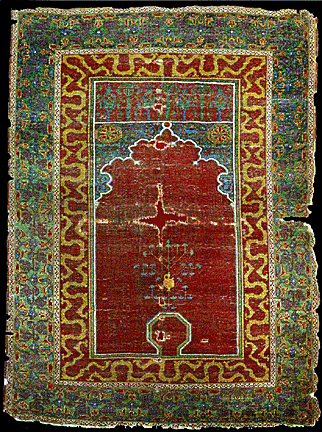 Appearing
early in Islamic history, the most common and basic design almost looks
like a door to heaven. The rug is in the shape of a vertical rectangle,
with a woven arched doorway, a mihrab, an ornamental niche in the
wall of a mosque, which marks the direction of the qibla, which
is the Kaaba in Mecca. Muslims pray in the direction of the qibla.
From a pointed arch supported by columns on either side to a variation
of a stylized “tree of life” design, there have been many creative
improvisations added over the decades by different weavers. Many rugs
also show one or more mosque lamps, a reference to the Verse of Light in
the Qur'an. Appearing
early in Islamic history, the most common and basic design almost looks
like a door to heaven. The rug is in the shape of a vertical rectangle,
with a woven arched doorway, a mihrab, an ornamental niche in the
wall of a mosque, which marks the direction of the qibla, which
is the Kaaba in Mecca. Muslims pray in the direction of the qibla.
From a pointed arch supported by columns on either side to a variation
of a stylized “tree of life” design, there have been many creative
improvisations added over the decades by different weavers. Many rugs
also show one or more mosque lamps, a reference to the Verse of Light in
the Qur'an.
Prayer rugs sometimes show specific mosques, including those in Mecca,
Medina, and especially Jerusalem. Decorations not only play a role in
imagery but serve the worshiper as aids to memory. Some of the examples
include a comb and pitcher, which is a reminder for Muslims to wash
their hands and for men to comb their hair before performing prayer.
Another important use for decorations is to aid newly converted Muslims
by stitching decorative hands on the prayer rug where the hands should
be placed when performing prayer.
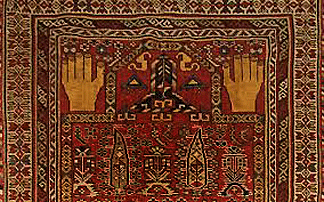 Antique
prayer rugs are usually made in the towns or villages of the communities
who use them and are often named after the origins of those who deal and
collect them. The exact pattern varied greatly by original weavers and
the different materials used. Some may have patterns, dyes and materials
that are traditional to the region in which they were made. Antique
prayer rugs are usually made in the towns or villages of the communities
who use them and are often named after the origins of those who deal and
collect them. The exact pattern varied greatly by original weavers and
the different materials used. Some may have patterns, dyes and materials
that are traditional to the region in which they were made.
There are many prayer rugs in existence today that have been taken care
of for more than a century. In most cases, they have been immediately
and carefully rolled after each prayer.
What to Look for in a Prayer Rug
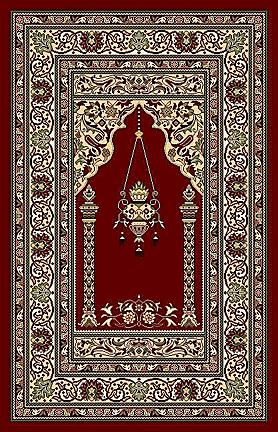 The
patterns, designs, and dyes of older prayer rugs can tell their origin,
which tribe or village made them, what message they tried to
communicate, and whether someone regularly used them or not based on
wear or tear. The
patterns, designs, and dyes of older prayer rugs can tell their origin,
which tribe or village made them, what message they tried to
communicate, and whether someone regularly used them or not based on
wear or tear.
One example of a classic prayer rug design is a 100-year-old Ottoman
prayer rug, which has a traditional Ramadan fanous, a glass
lantern or lamp, at the niche, which hung surrounded by Quranic
calligraphy along the rug’s borders.
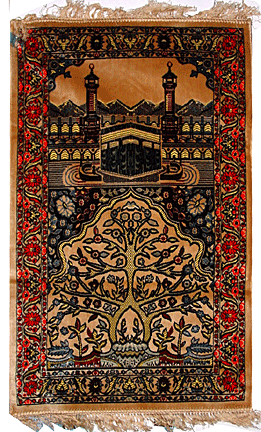 Another antique prayer rug , made by the Turkmen tribes of Jewish
descent, was known for its vibrant colors—a mix of orange, red, green
and blue---and for its rare message. It featured a small church and a
cross as well as a Jewish menorah. The maker of this rug wanted to show
the tolerance of all religions as well as their unity in prayer. Every
time someone prayed on the rug, they would pray to the one God. Another antique prayer rug , made by the Turkmen tribes of Jewish
descent, was known for its vibrant colors—a mix of orange, red, green
and blue---and for its rare message. It featured a small church and a
cross as well as a Jewish menorah. The maker of this rug wanted to show
the tolerance of all religions as well as their unity in prayer. Every
time someone prayed on the rug, they would pray to the one God.
While
these rare rugs cost tens of thousands of dollars, there are ethnic
prayer rugs that are more affordable and yet have their own stories to
share.
While many prayer rugs are collector’s items, beginning collectors can
find other designs available in silk, cotton or wool, which can include
animal motifs, featuring creatures such as peacocks and deer, as well as
religious symbols and Islamic calligraphy.
Whatever the design, age, color and size, a prayer rug remains one of
the most cherished items in a Muslim home, where people will usually
have a personal one, and others for guests who happen to visit.
< Back to Collecting Archives
Next Article > |
|

|
|
FOLLOW MY WEEKLY BLOG
Antiques Q&A
JOIN MY COLLECTION
Antiques and More
on Facebook
LIKE MY FACEBOOK PAGE
The Antiques
Almanac on Facebook |
|
No antiques or collectibles
are sold on this site.
|
|
How to Recognize and
Refinish Antiques for Pleasure and Profit
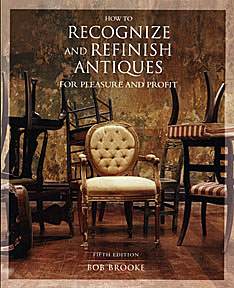
Have
you ever bought an antique or collectible that was less than perfect and
needed some TLC? Bob's new book offers tips and step-by- step
instructions for simple maintenance and restoration of common antiques.
Read an
Excerpt
|
|

|
|
|
|
|
